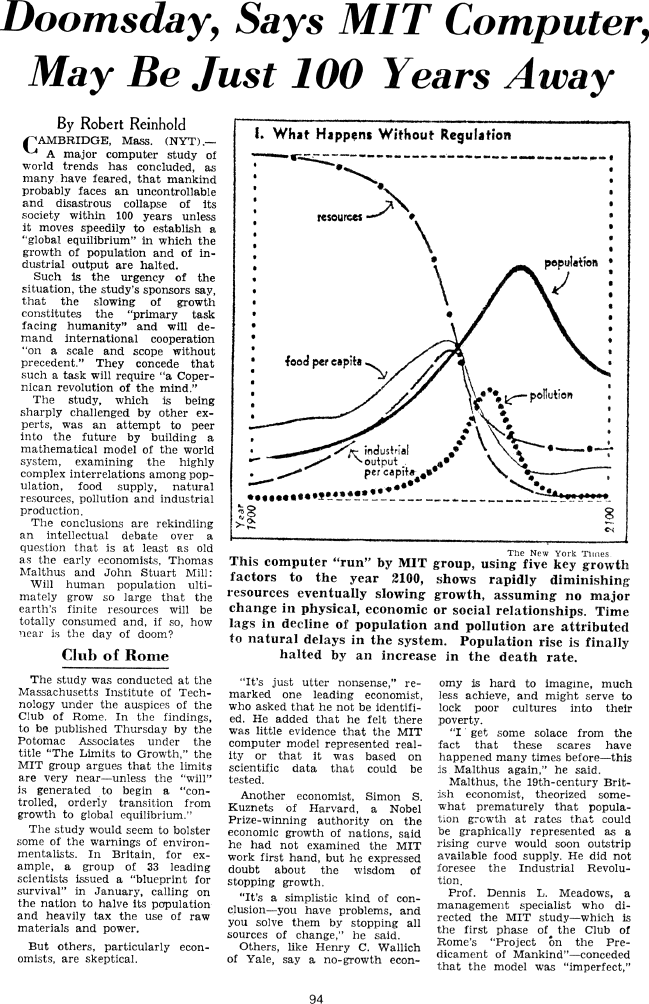The Best of Creative Computing Volume 1 (published 1976)
Doomsday, Says MIT Computer, May Be Just 100 Years Away (collapse of society by year 2100. From New York Times)

Doomsday, Says MIT Computer, May Be Just 100 Years Away
By Robert Reinhold
CAMBRIDGE, Mass. (NYT). -- A major computer study of world trends has concluded,
as many have feared, that mankind probably faces an uncontrollable and
disastrous collapse of its society within 100 years unless it moves speedily to
establish a ”global equilibrium” in which the growth of population and of
industrial output are halted. Such is the urgency of the situation, the study's
sponsors say, that the slowing of growth constitutes the ”primary task facing
humanity” and will demand international cooperation ”on a scale and scope
without precedent.” They concede that such a task will require ”a
Copernician revolution of the mind.”
The study, which is being sharply challenged by other experts, was an attempt to
peer into the future by building a mathematical model of the world system,
examining the highly complex interrelations among population, food supply,
natural resources, pollution and industrial production.
The conclusions are rekindllng an intellectual debate over a question that is at
least as old as the early economists, Thomas Malthus and John Stuart Mill: Will
human population ultimately grow so large that the
earth's finite resources will be totally consumed and, if so, how near is the
day of doom?
Club of Rome
The study was conducted at the Massachusetts Institute of Technology under the
auspices of the Club of Rome. In the findings, to be published Thursday by the
Potomac Associates under the title ”The Limits to Growth,” the MIT group
argues that the limits are very near-unless the "will" is generated to begin a
"controlled, orderly transition from growth to global equilibrium.”
The study would seem to bolster some of the warnings of environmentalists. In
Britain, for example, a group of 33 leading scientists issued a ”blueprint for
survival”in January, calling on the nation to halve its population and heavily
tax the use of raw materials and power.
But others. particularly economists, are skeptical.
”It's just utter nonsense,” remarked one leading economist, who asked that
he not be identified. He added that he felt there was little evidence that the
MIT computer model represented reality or that it was based on scientific data
that could be tested.
Another economist, Simon S. Kuznets of Harvard, a Nobel Prize-winning authority
on the economic growth of nations, said he had not examined the MIT work first
hand, but he expressed doubt about the wisdom of stopping growth.
”It‘s a simplistic kind of conclusion-you have problems, and you solve them
by stopping all sources of change,” he said. Others, like Henry C. Wallich of
Yale, say a no-growth economy is hard to imagine, much less achieve, and might
serve to lock poor cultures into their poverty. ”I get some solace from the
fact that these scares have happened many times before-this Malthus again,” he
said.
Malthus, the 19th-century British economist, theorized somewhat prcmaturely that
population growth at rates that could be graphically represented as a rising
curve would soon outstrip available food supply. He did not foresee the
Industrial Revolution.
Prof. Dennis L. Meadows, a management specialist who directed the MIT
study-which is the first phase of the Club of Rome's ”Project on the
Predicament of Mankind"-conceded that the model was ”imperfect.”
What Happens Without Regulation
This computer ”run” by MIT group, using five key growth factors to the year
2100, shows rapidly diminishing resources eventually slowing growth, assuming no
major change in physical, economic or social relationships. Time lags in
decline of population and pollution are attributed to natural delays in the
system. Population rise is finally halted by an increase in the death rate.


